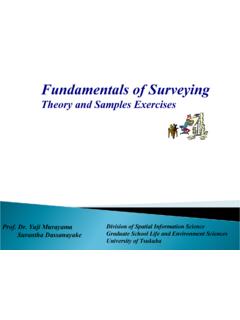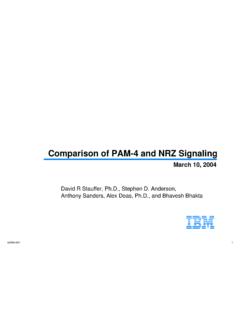Transcription of Species diversity in vertical, horizontal, and temporal ...
1 Biological Journal of the Linnean Society (1997), 62: 343 364. With 8 figures Species diversity in vertical , horizontal , and temporal dimensions of a fruit-feeding butterfly community in an Ecuadorian rainforest PHILIP J. DeVRIES1, DEBRA MURRAY2 AND RUSSELL LANDE1. 1. Department of Biology, University of Oregon, Eugene, Oregon 97403 1210, ;. 2. Department of Entomology, Louisiana State University, Baton Rouge, Louisiana 70803, Received 7 November 1996; accepted for publication 14 March 1997. To test the hypotheses that fruit-feeding nymphalid butterflies are randomly distributed in space and time, a community of fruit-feeding nymphalid butterflies was sampled at monthly intervals for one year by trapping 6690 individuals of 130 Species in the canopy and understory of four forest habitats: primary, higraded, secondary, and edge.
2 The overall Species abundance distribution was well described by a lognormal distribution. Total Species diversity (c- diversity ) was partitioned into additive components within and among community subdivisions (a- diversity and b- diversity ) in vertical , horizontal and temporal dimensions . Although community subdivisions showed high similarity (1 b- diversity /c- diversity ), sig- nificant b- diversity existed in each dimension. Individual abundance and observed Species richness was lower in the canopy than in the understory. However, rarefaction analysis and Species accumulation curves revealed that canopy had higher Species richness than understory. Observed Species richness was roughly equal in all habitats, but individual abundance was much greater in edge, largely due to a single, specialist Species .
3 Rarefaction analysis and Species accumulation curves showed that edge had significantly lower Species richness than all other habitats. Samples from a single habitat, height and time contained only a small fraction of the total community Species richness. This study demonstrates the feasibility, and necessity, of large-scale, long-term sampling in multiple dimensions for accurately measuring Species richness and diversity in tropical forest communities. We discuss the importance of such studies in conservation biology. 1997 The Linnean Society of London ADDITIONAL KEY WORDS: Nymphalidae Species abundance distribution Species richness rarefaction Species accumulation surve vertical stratification environmental monitoring habitat disturbance conservation.
4 CONTENTS. Introduction .. 344. Material and methods .. 345. Study site .. 345. Study community .. 345. Correspondence to Dr P. J. DeVries. Email: 343. 0024 4066/97/110343+22 $ 1997 The Linnean Society of London 344 P. J. DEVRIES ET AL. Field methods .. 346. Statistical analyses .. 347. Results .. 348. Discussion .. 357. Acknowledgements .. 361. References .. 361. INTRODUCTION. In view of global destruction of tropical forests, the measurement of Species diversity has become critically important to understanding tropical communities and their conservation. However, due to the extraordinary Species richness in tropical forests, relatively few studies have documented variation in Species abundance distributions of tropical organisms through space and time ( Hubbell & Foster, 1986; Morse, Stork & Lawton, 1988; Wolda, 1978, 1992; Terborgh et al.)
5 , 1990;. Gill, 1991; Hanski & Cambefort, 1991b). Instead, most recent efforts to estimate tropical diversity for conservation have concentrated on performing rapid inventories ( Roberts, 1991; Anon, 1993), utilizing focal taxa ( Noss, 1990; Pearson, 1994; Pearson & Cassola, 1992; Ryti, 1992), or developing extrapolation techniques to estimate diversity in a variety of habitat types (Colwell & Coddington, 1994;. Vane-Wright, Humphries & Williams, 1991; Hammond, 1994; Kiester et al., 1996). The stratification of biota between forest canopy and understory is a significant factor contributing to tropical diversity . Although vertical stratification has been documented in tropical mammals (Allee, 1926), birds (Pearson, 1977), plants (Rich- ards, 1952), and various insect groups (Bates, 1944; Sutton & Hudson, 1980; DeVries, 1988; Stork, 1988; Longino & Nadkarni, 1990; Gill, 1991; Erwin, 1995; Mallet &.
6 Gilbert, 1995; Beccaloni, in press), the importance of stratification as a component of diversity is seldom addressed or measured directly. Despite the increasing interest in canopy biotas (Erwin, 1982, 1990; Morse et al., 1988; Basset & Kitching, 1991;. Lowman & Nadkarni, 1995), few studies have simultaneously measured Species diversity in both canopy and understory environments through time ( DeVries, 1988; Longino & Nadkarni, 1990; Malcolm, 1994; Wolda, 1992). Considering that over half of all described Species are insects (Groombridge, 1992), this group is of central importance to understanding patterns and processes of biological diversification. Due to their relatively large size, colourful appearance, ease of sampling, and broad appeal, butterflies are the best known group of insects and offer great potential for understanding insect diversity and conservation.
7 Butterfly studies have been used as models of tropical insect diversity (see Vane-Wright &. Ackery, 1984; Brown, 1991; DeVries, 1987, 1997; Lamas, Robbins & Harvey, 1991;. Malcolm & Zalucki, 1993; Robbins et al., 1996, and references therein), and particular butterfly taxa have been used to predict patterns of diversity in conservation studies ( Kremen, 1992, 1994; Kremen et al. 1993; Beccaloni & Gaston, 1995; Scriber, Tsubaki & Lederhouse, 1995). However, as is the case for studies on other insect groups, those concerned with butterflies are often restricted in scope and experimental design. Typical problems include short sampling periods and poor temporal res- olution, sampling methods that are non-comparable to other areas, the use of presence-absence data only, extrapolation from small sample sizes, and a lack of data on vertical distributions within communities.
8 A deeper understanding of tropical insect diversity can be achieved through Species diversity IN ECUADORIAN RAINFOREST BUTTERFLIES 345. studies that partition diversity along different habitat dimensions , with sample sizes large enough to allow measurement of diversity among several subsets of a com- munity. Such studies will encourage the acquisition of comparative data important for testing hypotheses that address ecological dynamics and the conservation of tropical insects. Accordingly, we report here a study of a diverse community of fruit- feeding nymphalid butterflies that was designed to test the hypotheses that these butterflies are randomly distributed in space and time. We provide estimates of Species richness, abundance, seasonal changes, and vertical stratification among adjacent habitats in a neotropical rainforest.
9 After describing the Species abundance distribution of our sample from the community, we partition the measures of diversity among subsets of the community in multiple dimensions and analyse them statistically. This study demonstrates the feasibility of gathering large standardized samples in multiple dimensions for a diverse community of tropical forest insects, and illustrates statistical methods for analysing diversity in different dimensions . To our knowledge this study represents the most extensive data set gathered on a Species -rich guild of tropical butterflies at one site, and thus provides a model for developing a more profound understanding of tropical insect diversity by pointing to testable ecological patterns that are important to conservation biology.
10 MATERIAL AND METHODS. Study site This research was conducted at the Jatun Sacha Biological Station and Reserve, Napo Province, eastern Ecuador (01 4 S; 77 36 W). The 1700 hectare reserve lies at the base of the eastern Andes in the upper Amazon Basin and is bounded by the Rio Napo and the Rio Arahuno. A brief description of Jatun Sacha that is pertinent to this study is provided below; a broader description of the entire reserve can be found in Pearman, Velasco & Lopez (1995). The Jatun Sacha Reserve comprises a patchwork of habitats that include substantial areas of primary forest (where most edible mammals and birds have been hunted out), smaller areas where select timber Species were extracted by local people about 15 20 years ago (hereafter referred to as higraded), a section consisting of secondary forest that was clear cut about 15 20.








